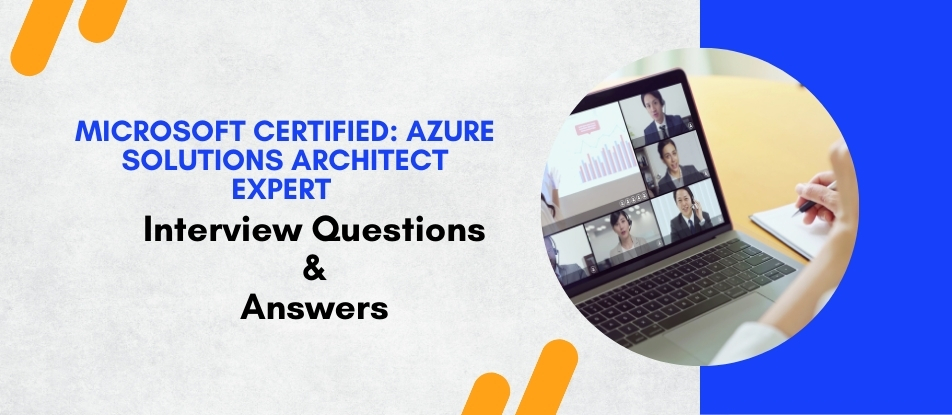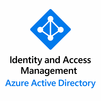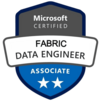
Achieve Microsoft Certified: Azure Solutions Architect Expert status through our intensive training program. Explore designing, implementing, and managing Azure solutions with a focus on security, scalability, networking, and governance. Engage in hands-on labs, expert-led sessions, and practical assessments to develop the expertise needed to architect effective and innovative cloud solutions on Microsoft Azure.
Microsoft Certified: Azure Solutions Architect Expert Interview Questions Answers - For Intermediate
1. What Azure service would you use to manage and deploy containerized applications?
Azure Kubernetes Service (AKS) is used to manage and deploy containerized applications. It simplifies Kubernetes cluster management, automates deployment, scaling, and operations of application containers, and integrates with Azure DevOps for CI/CD pipelines.
2. How does Azure Traffic Manager achieve high availability?
Azure Traffic Manager uses DNS-based load balancing to distribute traffic across multiple endpoints globally. It monitors endpoint health and directs users to the most responsive or available service, ensuring high availability and optimal performance.
3. What is the purpose of Azure Resource Manager (ARM)?
Azure Resource Manager (ARM) is the deployment and management service for Azure. It provides a consistent management layer, enabling the creation, updating, and deletion of resources in a resource group through templates, ensuring organized and repeatable deployments.
4. Explain Azure Virtual Network (VNet) peering.
VNet peering connects two Azure Virtual Networks, allowing resources in different VNets to communicate securely using private IP addresses. It offers low latency, high-bandwidth connectivity without the need for gateways, and supports cross-region peering for global architectures.
5. What is Azure Active Directory (Azure AD) and its key features?
Azure Active Directory is Microsoft’s cloud-based identity and access management service. Key features include single sign-on (SSO), multi-factor authentication (MFA), conditional access policies, identity protection, and integration with various SaaS applications for secure user access.
6. How do Azure Availability Sets improve application reliability?
Azure Availability Sets ensure that VMs are distributed across multiple fault domains and update domains. This distribution minimizes downtime during hardware failures or maintenance, enhancing application reliability and ensuring high availability within Azure data centers.
7. Describe Azure Blob Storage tiers and their use cases.
Azure Blob Storage offers Hot, Cool, and Archive tiers. Hot is for frequently accessed data, Cool for infrequently accessed data with lower storage costs, and Archive for rarely accessed data with the lowest storage costs but higher retrieval times, suitable for backups and long-term storage.
8. What is Azure Policy and how is it used?
Azure Policy is a governance tool that enforces organizational standards and compliance. It defines rules and effects to manage resources, ensuring they adhere to policies such as allowed regions, resource types, and configurations, helping maintain consistency and security.
9. Explain the role of Azure Load Balancer in a solution architecture.
Azure Load Balancer distributes incoming network traffic across multiple VMs to ensure no single server becomes a bottleneck. It supports high availability, scalability, and reliability for applications by balancing traffic based on configurable rules and health probes.
10. How does Azure Site Recovery facilitate disaster recovery?
Azure Site Recovery automates the replication of on-premises physical or virtual machines to Azure. In case of a disaster, it enables failover to Azure with minimal downtime and data loss, and supports seamless failback after recovery, ensuring business continuity.
11. What is Azure Cosmos DB and its key features?
Azure Cosmos DB is a globally distributed, multi-model database service. Key features include low latency, automatic scaling, multiple consistency models, and support for various APIs (SQL, MongoDB, Cassandra, etc.), making it ideal for scalable, high-performance applications.
12. Describe the use of Azure Functions in a serverless architecture.
Azure Functions are event-driven, serverless compute services that execute code in response to triggers. They allow developers to build scalable applications without managing infrastructure, supporting various languages, and integrating with other Azure services for efficient workflows.
13. What is Azure ExpressRoute and its benefits?
Azure ExpressRoute establishes a private, dedicated connection between on-premises infrastructure and Azure data centers. Benefits include higher security, lower latency, increased reliability, and consistent network performance, bypassing the public internet.
14. How does Azure Monitor assist in managing Azure resources?
Azure Monitor provides comprehensive monitoring for Azure resources by collecting metrics, logs, and telemetry data. It offers alerting, visualization through dashboards, and insights for performance tuning, troubleshooting, and ensuring the health and availability of applications.
15. What are Azure Managed Identities and their use cases?
Azure Managed Identities provide Azure services with an automatically managed identity in Azure AD. They eliminate the need for credentials in code, enabling secure access to other Azure services like Azure Key Vault, databases, and APIs without managing secrets.
16. Explain the concept of Azure Governance and its components.
Azure Governance ensures resources are managed consistently and comply with organizational standards. Components include Azure Policy for enforcing rules, Azure Blueprints for deploying compliant environments, role-based access control (RBAC) for permissions, and management groups for hierarchical resource management.
17. What is Azure Bastion and its advantages?
Azure Bastion is a managed service that provides secure RDP and SSH access to VMs directly through the Azure Portal without exposing them via public IP addresses. Advantages include enhanced security, no need for jump boxes, and protection against port scanning and brute-force attacks.
18. How does Azure SQL Database ensure high availability?
Azure SQL Database ensures high availability through built-in features like automated backups, geo-replication, failover groups, and the use of redundant storage. It offers a service-level agreement (SLA) with up to 99.99% availability, minimizing downtime and data loss.
19. Describe the role of Azure Key Vault in securing applications.
Azure Key Vault securely stores and manages sensitive information like secrets, keys, and certificates. It provides controlled access, integrates with other Azure services, supports encryption, and ensures compliance, helping protect application data and credentials from unauthorized access.
20. What is Azure DevOps and how does it integrate with Azure services?
Azure DevOps is a suite of development tools for CI/CD, version control, project management, and collaboration. It integrates seamlessly with Azure services to automate deployments, manage infrastructure as code, track work items, and streamline the software development lifecycle.
Microsoft Certified: Azure Solutions Architect Expert Interview Questions Answers - For Advanced
1. How would you implement a secure hybrid identity solution integrating on-premises Active Directory with Azure AD, ensuring single sign-on and conditional access policies?
Use Azure AD Connect to synchronize on-premises AD with Azure AD. Implement Azure AD Seamless Single Sign-On for SSO. Enable Multi-Factor Authentication (MFA) and configure Conditional Access policies based on user, location, and device compliance. Utilize Azure AD Pass-through Authentication or Federation Services for authentication, ensuring secure and seamless hybrid identity management.
2. Design a scalable data storage solution for a globally distributed application requiring low latency and high availability. Which Azure services would you use and why?
Use Azure Cosmos DB for globally distributed, low-latency data storage with multi-region replication. Implement Azure Front Door for global load balancing and CDN capabilities. Utilize Azure Blob Storage for unstructured data. Combine with Azure Traffic Manager to route users to the nearest regions, ensuring high availability and optimal performance across the globe.
3. How can you ensure business continuity for an Azure-based application in the event of a regional outage? Describe the architecture and services involved.
Deploy the application across multiple Azure regions using paired regions for redundancy. Use Azure Traffic Manager or Front Door for geo-routing and failover. Implement Azure SQL Database with geo-replication and Azure Storage with RA-GRS. Utilize Azure Site Recovery for orchestrated failover. Ensure data synchronization and regular backups to maintain consistency and availability during outages.
4. Describe how to implement network security in Azure using Network Security Groups, Azure Firewall, and DDoS protection.
Use Network Security Groups (NSGs) to control inbound/outbound traffic at subnet and VM levels. Deploy Azure Firewall for centralized, scalable threat protection and application-level filtering. Enable Azure DDoS Protection Standard to safeguard against volumetric and sophisticated DDoS attacks. Integrate these services to create layered security, ensuring comprehensive network protection.
5. How would you design a multi-tier application in Azure to optimize performance and security?
Implement a three-tier architecture with Azure Front Door or Application Gateway for the presentation layer, Azure App Services or Virtual Machines for the application layer, and Azure SQL Database for the data layer. Use Virtual Networks and Subnets to isolate tiers. Apply NSGs, Azure Firewall, and Private Endpoints for security. Utilize caching with Azure Cache for Redis and autoscaling for performance optimization.
6. What strategies would you use to manage and monitor Azure resources effectively in a large-scale deployment?
Implement Azure Monitor and Azure Log Analytics for comprehensive monitoring. Use Azure Policy for governance and compliance. Utilize Azure Resource Manager (ARM) templates and Infrastructure as Code (IaC) for consistent deployments. Employ Azure Cost Management for budgeting. Leverage Azure Automation for routine tasks and integrate with Azure Sentinel for security monitoring, ensuring efficient management at scale.
7. Explain how to secure data at rest and in transit in Azure, specifying relevant services and configurations.
For data at rest, use Azure Storage Service Encryption and Transparent Data Encryption (TDE) for databases. Implement Azure Key Vault to manage encryption keys. For data in transit, enforce TLS/SSL for all communications. Utilize Azure VPN or ExpressRoute with encryption for hybrid scenarios. Apply network security measures like NSGs and Azure Firewall to protect data flows, ensuring comprehensive data security.
8. How would you implement disaster recovery for an Azure virtual machine environment?
Use Azure Site Recovery to replicate VMs to a secondary region. Configure Recovery Plans with failover and failback procedures. Ensure regular testing of DR plans without impacting production. Utilize Azure Backup for VM snapshots and data protection. Implement geo-redundant storage and automate recovery workflows, ensuring minimal downtime and data loss during disasters.
9. Describe the process of migrating an on-premises application to Azure, addressing assessment, planning, and execution phases.
Begin with assessment using Azure Migrate to evaluate application dependencies and readiness. Plan by selecting appropriate Azure services, designing architecture, and defining migration strategies (rehost, refactor). Execute migration through tools like Azure Site Recovery or Database Migration Service. Validate functionality, optimize performance, and ensure security post-migration. Document and train teams for ongoing management.
10. What are the best practices for implementing Identity and Access Management (IAM) in Azure to ensure the least privilege and secure access?
Adopt Role-Based Access Control (RBAC) to assign minimal necessary permissions. Use Azure AD Privileged Identity Management (PIM) for just-in-time access. Implement Multi-Factor Authentication (MFA) for all users. Regularly review and audit access roles and permissions. Utilize Conditional Access policies to enforce access based on context, ensuring secure, least-privilege IAM in Azure.
Course Schedule
| Nov, 2025 | Weekdays | Mon-Fri | Enquire Now |
| Weekend | Sat-Sun | Enquire Now | |
| Dec, 2025 | Weekdays | Mon-Fri | Enquire Now |
| Weekend | Sat-Sun | Enquire Now |
Related Courses
Related Articles
- How IBM MDM InfoSphere Training Can Advance Your Career?
- Workday HCM Certification Cost - A Handbook for Ambitious Professionals
- Palantir Foundry Data Science Training: A Smart Career Move
- Why BIM Revit Architects Are Essential for Future-Ready Infrastructure
- Check Out the Most Trending Questions & Answers for AI Interview
Related Interview
Related FAQ's
- Instructor-led Live Online Interactive Training
- Project Based Customized Learning
- Fast Track Training Program
- Self-paced learning
- In one-on-one training, you have the flexibility to choose the days, timings, and duration according to your preferences.
- We create a personalized training calendar based on your chosen schedule.
- Complete Live Online Interactive Training of the Course
- After Training Recorded Videos
- Session-wise Learning Material and notes for lifetime
- Practical & Assignments exercises
- Global Course Completion Certificate
- 24x7 after Training Support







.jpg)

 Join our Live Instructor-Led online classes delivered by industry experts
Join our Live Instructor-Led online classes delivered by industry experts